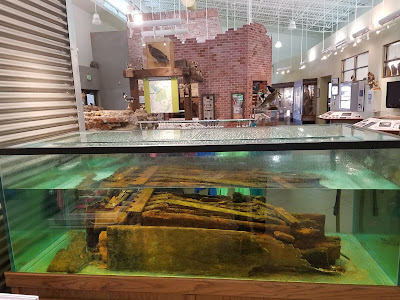 |
| The CSS Stono rifles (Photos by Don Scarbrough, interpretive range at SCSP) |
The crate carried by the blockade runner CSS Stono has been
on display for seven years at Sweetwater Creek State Park in Douglas
County, west of Atlanta. The British-made Enfield was the second-most widely
used infantry weapon in the Civil War after the Springfield.
The aim is to eventually display the weapons out of water, said Josh
Headlee, curator and historic
preservation specialist with the Georgia Department of Natural Resources.
 |
| The crate when it appeared briefly uncovered by water in January |
“This is something that most museum professionals or conservators are
familiar with – before you use a product on an important artifact you test it
on a “non-important” item or in a well-hidden spot on the artifact before you
use it on the entire item.”
The products
are designed to displace water in the wood with preservatives that help to
solidify the wood so it can be permanently exposed to the air. “We just want to
make sure that what we do isn’t going to harm the rifles in any way," said Headlee.
 |
| The visitor center is currently closed due to the coronavirus pandemic |
An archaeological diver pulled up the crate from the South Carolina shipwreck in the late 1980s. Officials did not initially know how many of the highly-prized Pattern 53 rifles were inside, their position or condition. Each weapon originally weighed about 9 pounds and was approximately 53 inches long. The bore is .577-caliber.
Every six months or so, technicians travel to Sweetwater Creek to examine
the cache and clean the tank. Last year, Headlee said the remains of the walnut rifle stocks were in good shape, while the crate itself and a metal lining that
protected the rifles have not fared so well. The
crate is likely made of pine, a softer wood. And the metal lining, made of an
alloy, appears to be waterlogged. The iron rifle barrels, locks and bayonets deteriorated because of years of saltwater corrosion.
In January, technicians drained the
3,000-gallon tank and again cleaned the crate and installed a new filter.
 |
| A closeup view of the rifle stock remnants (Don Scarbrough) |
“It pretty
much cleared up right away,” Sweetwater interpretive ranger Don Scarbrough said
of the tank’s appearance following the work in January.
Because of the coronavirus pandemic, the
Sweetwater visitor center housing the aquarium has been closed since
mid-March.
The park staff recently resumed tours of the ruins of the New Manchester textile mill, which operated during the Civil War, Scarbrough said.
The park staff recently resumed tours of the ruins of the New Manchester textile mill, which operated during the Civil War, Scarbrough said.
No comments:
Post a Comment